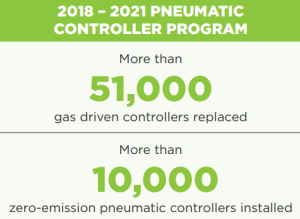The U.S. oil and natural gas industry continues to make tremendous strides in reducing methane emissions thanks to technological advancements, industry innovation, and collaboration in coalitions like the voluntary Environmental Partnership.
The Partnership’s recently released 2022 Annual Report highlights these advancements across primary sources of industry emissions detailed by the Environmental Protection Agency’s Greenhouse Gas Reporting program, including: reducing flaring, replacing gas-driven pneumatic controllers with low- or zero-emitting devices, and reducing leak occurrence rates.
Let’s look at the highlights:
Cutting Flaring Intensity Nearly in Half
Launched in 2020 as a critical program to manage flaring and reduce flaring intensity, the 2022 report details the industry’s success in cutting flare intensity nearly in half for the second year in a row.
“In 2021, There was a 40 percent increase in the number of participating companies in the flare management programs. These companies represent 62 percent and 40 percent of total U.S. oil and natural gas production, respectively. Including new company participants, there was a 45 percent reduction in flare intensity and a 26 percent reduction in total flare volumes from the previous year.” (emphasis added)

Reducing flaring not only means more natural gas is able to get to market to meet growing energy demand but also ensures a cleaner environment with less greenhouse gas emissions released into the air.
Reducing Leak Occurrence to 0.05 Percent
By focusing on leak detection and repairs, participating companies were able to reduce leak occurrence rates to 0.05 percent among the nearly 100,000 sites surveyed, or less than one component leaking for every 2,000 sites.
The report highlights the aggressive actions companies are taking to expand their leak detection programs, including:
As the report explains:
“Across every major oil and natural gas basin in the country, the participating companies conducted more leak surveys than ever focused on reducing methane emissions.” (emphasis added)
Many companies have achieved this growth through technological advancements such as remote monitoring with satellites, laser-based aerial surveys, and other continuous monitoring technology that allow companies to detect and fix methane emissions in real time.
Replacing Pneumatic Controllers with Low- or Zero-Emitting Devices
In 2021 alone, more than 22,400 gas driven controllers were replaced or removed while more than 4,500 zero-emission pneumatic controllers were installed at new sites, demonstrating the industry’s commitment to modernizing equipment that better serves the environment.
Importantly, according to the report, more than 1,700 high-bleed pneumatic controllers were replaced, retrofitted, or removed from service, and 60 participating companies no longer have high-bleed pneumatic controllers in their operations entirely.
This is on top of the tremendous progress the industry has made since the Environmental Partnership began tracking:

Additional highlights of the report include improved emissions reduction practices on manual liquids unloading, compressor programs, and during pipeline blowdowns.

Voluntary Collaboration, Not Regulatory Requirements
Launched in December of 2017 with just 23 companies, the Environmental Partnership has seen tremendous growth, now representing 100 companies that make up more than 70 percent of the U.S. onshore oil and natural gas industry, including 47 of the 50 states. This growth, coupled with continued methane reduction, highlights the industry’s commitment to responsible operations through innovation and collaboration, not just mandates or regulation.
The Environmental Partnership report emphasizes its conferences and workshops in 2021 that allowed upstream and midstream operators to come together to share learnings, best practices, new technologies and more that have all contributed significantly to reducing the industry’s methane footprint.
The Environmental Partnership’s Director Matthew Todd said:
“As our industry continues to drive solutions to better detect and reduce methane emissions, The Environmental Partnership will continue to serve as a springboard to advance technological innovation, cultivate best practices and take action to improve our environmental performance.”
Bottom Line: Thanks to leadership and innovations by the oil and natural gas industry, the United States is leading the world in both reducing emissions and oil and natural gas production that fuels America and the globe. For the fourth year in a row, the Environmental Partnership report underscores that the oil and natural gas industry is committed to driving innovation and collaborating to produce best methane mitigation practices across all U.S. basins.